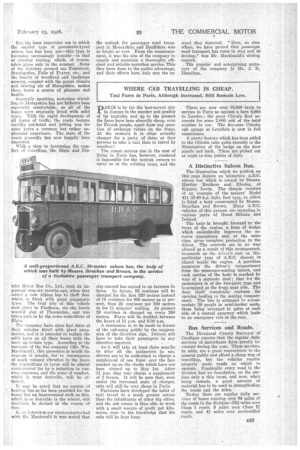WHERE CAB TRAVELLING IS CHEAP.
Page 27

If you've noticed an error in this article please click here to report it so we can fix it.
Taxi Fares in Paris, Although Increased, Still Remain Low.
PAlas is by far the best-served city in Europe in the number and quality of its taxicabs, and up to the present the fares have been absurdly cheap, even for French people, apart from any question of exchange values on the franc. At the moment it is often actually cheaper for a party of three or four persons to take a taxi than to travel by omnibus!
The recent serious rise in the cost of living in Paris has, however, rendered it impossible for the taxicab owners to carry on at the existing rates, and the city council has agreed to an increase in fares. In future, 95 centimes will be charged for the first 320 metres instead of 75 centimes for 400 metres as at present, then 20 centimes per 160 metres or for 13 minutes' waiting. At present 20 centimes is charged up every 200 metres. Fares will be doubled between the hours of 11 p.m. and 6.30 a.m.
A concession is to be made in favour of the cab-using public by the suppression of the direction sign. Drivers will have to take their passengers in any direction required.
As it will take at least three months to alter all the taximeters in use,' drivers are to be authorized to charge a supplement of one franc over the fare marked up on the clocks which have not been altered up to May let. After 11 p.m. they may charge a supplement of 2 francs. It will be seen that, even under the increased scale of charges, cabs will still be very cheap in Paris.
Parisians have developed the habit of taxi travel to a much greater extent than the inhabitants of other big cities, and the cab owner is thus able to work with a small margin of profit per kilometre, sure in the knowledge that his cabs will be kept busy.
• There are now over 16,000 taxis in service in Paris as against a bare 8,000 In Loudon; the great Citron fleet accounts for some 2,000 odd of the total number in use. The five-acre Citrogn cab garage at Levallois is new in full Commission.
A pretty feature which has been added to the Citroan cabs quite recently is the illumination of the badge on the door panels and back. These are picked out at night in--tiny points of light.
A Distinctive Saloon Bus.
• The illustration which we publish on this page depicts an 'attractive A.E.C. saloon bus which is owned by Messrs. Hartley Brothers and Rhodes, of Kippax, Leeds. The chassis consists of an example of the makers' Model 411.35-40 h.p. light, fast type, to which is fitted a body constructed by Messrs. Strachan and Brown. Many A.E.C. vehicles of this pattern are operating in various parts of Great Britain and Ireland.
The body is brought forward to the front of the engine, a form of design which undoubtedly improves the exterior appearance and, at the same time, gives complete protection to the driver. The controls are in no way altered as a result of this arrangement, ivasmuch as the driver's seat on this particular type of A.E.C. chassis is placed beside the engine. A partition separates the driver's compartment from the passenger-seating saloon, and each section of the body is reached by way of a separate door ; that for the passengers is of the two-piete type and is arranged at the front near side. The door itself compleiay encloses the opening leading to the seating compartment. The bus is arranged to accommodate 30 people in semi-bucket seats, these being arranged in pairs at each side of a central gangway which leads to an emergency exit at the rear.
Bus Services and Roads.
The Divisional County Surveyor of Cardigan reports that the regular .daily services of motorbuses have greatly in. (Teased during the year. These services, he adds, are a great convenience to the general public and afford a cheap way of travelling, but the vehicles require properly made roads on which to operate. Practically every road in the division had no foundation, on the surface only a thin crust, and now, when being remade, a great amount of material has to be used in strengthening the roads and the sides.
To-day there are regular daily services of buses running over 64 miles of the roads in the division-50 -i miles over Class I roads. 9 miles over Class II roads. and V: miles over unclassified roads.






























